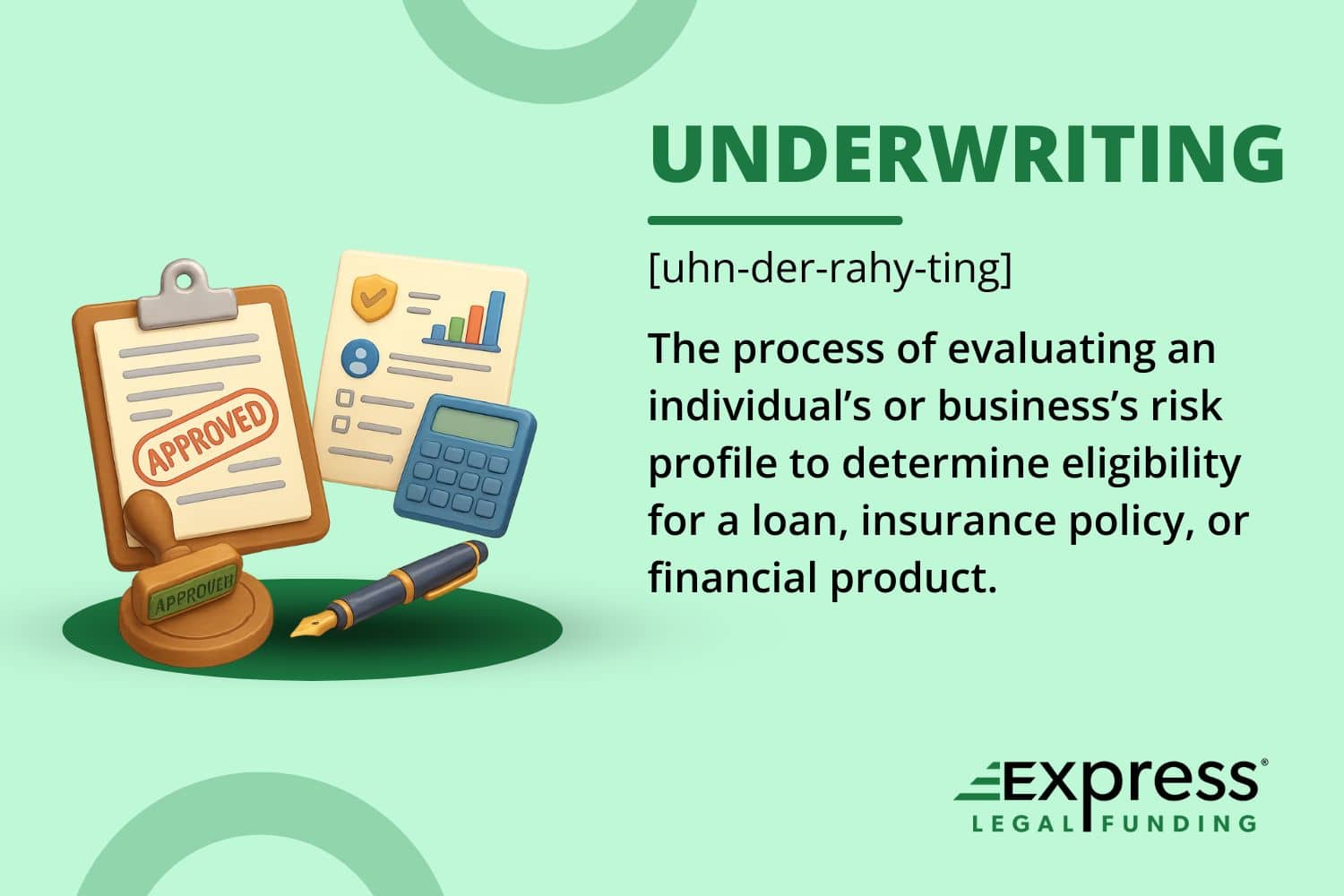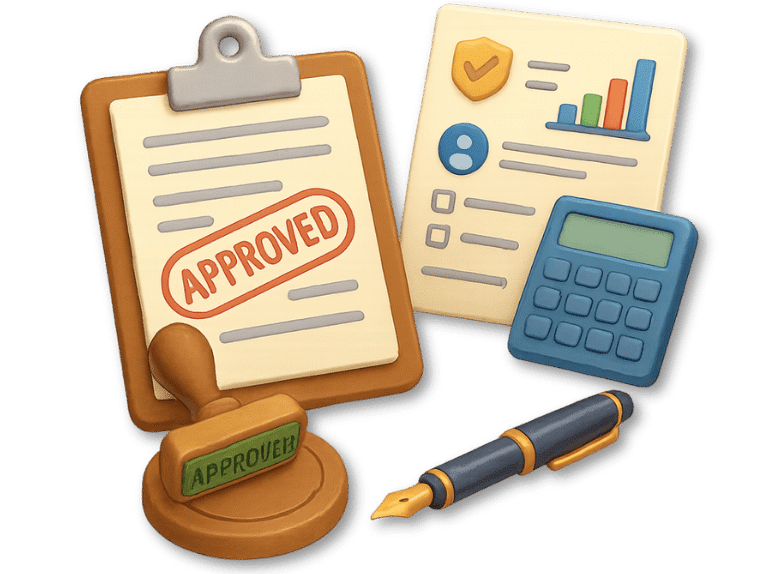Introduction to Underwriting
Underwriting is the process of evaluating risk to determine whether an individual or business qualifies for a loan, insurance policy, or other financial product. It plays a critical role in ensuring financial agreements are made responsibly by aligning applicants with terms that reflect their risk profile and repayment ability.
The concept of underwriting originated in 17th-century London at Lloyd’s of London, where merchants would sign their names underneath the amount of financial risk they were willing to assume for maritime ventures. This practice laid the foundation for modern risk assessment in finance and insurance.
Today, underwriting is a core function across several industries, including mortgage lending, insurance, banking, and investing.
Underwriters analyze financial documents, credit reports, income history, and other key data points to assess whether an applicant meets eligibility criteria. Their goal is to ensure that agreements are fair, sustainable, and structured to protect both the institution and the individual involved.
What Is Underwriting?

Underwriting is the process of assessing risk to determine whether an applicant qualifies for a financial product such as a loan, insurance policy, or investment. It is used by banks, insurers, and other financial institutions to evaluate whether offering a product to an individual or business is financially sound.
The core purpose of underwriting is to ensure that the level of risk involved is acceptable and manageable. This reduces the chance of financial losses for the institution while helping applicants receive products that align with their financial situation.
Underwriters assess various factors depending on the context. These may include:
- Financial stability and credit history
- Income and employment verification
- Property value and appraisal reports
- Health and medical records (for insurance)
- Prior claims or insurance history
Purpose of the Underwriting Process
Underwriting is one of the most essential steps in issuing loans, insurance policies, and financial products. Its primary purpose is to protect both the financial institution and the applicant by ensuring that agreements are based on the applicant’s ability to meet the terms.
Without underwriting, lenders and insurers would be exposed to excessive risk, which could lead to increased defaults, higher premiums, and financial instability. At the same time, applicants might be approved for contracts they cannot afford, setting them up for financial hardship. By accurately evaluating risk, underwriting helps maintain balance and fairness in the financial system.
In the United States, underwriting standards are influenced by various regulatory bodies depending on the product type:
- Mortgage lending: Government-sponsored enterprises like Fannie Mae and Freddie Mac provide widely adopted underwriting guidelines.
- Health and life insurance: Regulations vary by state and are governed by state insurance departments.
- Banking and loans: Oversight may come from federal agencies such as the Federal Reserve or the Office of the Comptroller of the Currency (OCC).
- Pre-settlement funding: Although not regulated like traditional loans, legal funding companies use internal underwriting criteria to evaluate the strength and potential value of a plaintiff’s case before advancing funds. Some states have enacted consumer legal funding laws to set standards for disclosures and practices.
Underwriting ensures compliance with these standards while aligning financial products with the risk tolerance and capacity of both the issuer and the applicant.
Key Parties Involved in Underwriting
- Underwriters: Professionals who review applications, evaluate risk, and determine whether to approve, deny, or modify the terms of the agreement.
- Lenders: Financial institutions or private entities that offer loans and rely on underwriting to ensure borrowers can repay the debt.
- Insurers: Companies that assume financial risk in exchange for premiums and use underwriting to decide coverage and pricing.
- Applicants: Individuals or businesses applying for financial products such as mortgages, insurance policies, or investment offerings.
What Are the Types of Underwriting?
Underwriting methods vary based on the financial product or service being evaluated. The most common types include:
- Mortgage Underwriting: Evaluates the borrower’s credit, income, debt, and the value of the property being financed.
- Insurance Underwriting: Assesses the risk of insuring an individual or property. Used in health, life, auto, and property insurance.
- Casualty Underwriting: Evaluates the risks associated with liability coverage, including personal injury, workers’ compensation, and third-party legal claims. Common in auto, commercial, and general liability insurance policies.
- Credit Underwriting: Focuses on creditworthiness for personal or business loans, including review of DTI, credit score, and collateral.
- Securities Underwriting: In investment banking, this involves assessing and assuming risk in initial public offerings (IPOs) and bond issuances.
- Auto Loan Underwriting: Combines credit underwriting with evaluation of the vehicle’s value, condition, and financing structure.
- Pre-settlement Funding Underwriting: Analyzes the legal merits and potential settlement value of a pending lawsuit rather than the applicant’s credit or income.
Underwriting Requirements
The specific requirements for underwriting vary by industry, but most financial institutions and insurers review similar types of documentation to assess risk. Common underwriting criteria include:
- Proof of income and employment: Pay stubs, W-2s, tax returns, or employment verification letters.
- Credit report and credit score: A full credit history is used to assess payment reliability and existing obligations.
- Debt-to-income (DTI) ratio: Evaluates whether the applicant has enough income to handle new debt responsibly.
- Asset statements: Bank statements, retirement accounts, or investment portfolios that demonstrate financial reserves.
- Insurance claim history: For insurance policies, past claims help assess risk exposure.
- Appraisal reports: Used in mortgage underwriting to confirm the value of the property.
- Medical records: Common in life and health insurance underwriting (subject to legal limitations in some states).
These documents collectively form the applicant’s risk profile and determine whether they qualify, under what terms, and at what cost.
What Documentation Is Typically Reviewed During Underwriting?
At the heart of the underwriting process is risk evaluation. The underwriter carefully reviews an applicant’s financial and personal information to determine their ability to meet the terms of the proposed agreement. Based on this assessment, the underwriter may approve, deny, or adjust the offer’s conditions, such as interest rates or coverage limits.
The documentation reviewed depends on the product type, but often includes the following:
- Income verification: Pay stubs, tax returns, or profit and loss statements for self-employed applicants.
- Employment history: Employer verification letters or W-2 forms to confirm job stability and consistency.
- Credit report: A full review of credit history, including credit score, payment history, and outstanding debts.
- Bank statements: Evidence of liquid assets, account balances, and spending patterns.
- Property appraisals: Independent evaluations of property value for mortgage or real estate-backed loans.
- Insurance history: Past claims and policy records used in auto, homeowners, or life insurance underwriting.
- Medical records: Health history, prescriptions, and screenings (primarily for life and health insurance underwriting, where allowed by law).
This documentation allows the underwriter to build a comprehensive profile of the applicant and match them with the appropriate financial or insurance product.
The Underwriting Process: Step-by-Step
While each institution may follow a slightly different procedure, the underwriting process typically includes the following stages:
1. Application Submission
The applicant submits required documents, which may include financial statements, tax records, personal identification, and any product-specific paperwork.
2. Initial Review
An underwriter or automated system checks the application for completeness. If documents are missing or inconsistent, the review is paused until clarified.
3. Risk Assessment
The underwriter evaluates the applicant’s risk using key criteria such as credit score, income stability, employment history, and other supporting information.
4. Request for Additional Information
If anything is unclear or insufficient, the underwriter contacts the applicant or loan officer for clarification or additional documentation.
5. Decision and Terms
Based on the analysis, the underwriter will either:
- Approve the application
- Deny the application
- Issue a conditional approval with specific requirements that must be met
6. Final Review and Approval
Once all conditions are satisfied, the underwriter issues final approval, and the loan, insurance policy, or financial agreement proceeds to closing or activation.
How Long Does Underwriting Take?
The time it takes to complete underwriting can vary depending on the type of loan, the lender’s process, and the complexity of the borrower’s financial profile. In general, underwriting takes anywhere from a few days to three weeks. This timeline includes time for document collection, verification, and back-and-forth communication between the borrower, lender, and underwriter.
Mortgage Loan Underwriting
Standard mortgage loans (including conventional, FHA, and VA) typically take 7 to 14 business days to move through underwriting, assuming the loan file is complete and there are no major issues. Delays can occur due to appraisal problems, missing documentation, or high loan volume.
Home Purchase Loan Underwriting
For new home purchase loans, underwriting generally takes 5 to 15 business days, depending on the lender’s internal processes, the applicant’s creditworthiness, and how quickly required documents are submitted.
Home Equity Loan or HELOC Underwriting
Home equity loans and home equity lines of credit (HELOCs) are usually underwritten more quickly than first mortgages. Underwriting is often completed within 5 to 10 business days, particularly if the borrower has strong credit, ample equity, and complete documentation submitted at the outset.
Why Does Underwriting Take So Long?
Underwriting can feel slow because it requires careful verification of every aspect of an applicant’s financial profile. Even when the borrower submits everything correctly, delays can arise due to appraisal scheduling, third-party verification, and the lender’s internal workload. If manual underwriting is required, the process may take longer since it involves more personalized review and discretion by a human underwriter.
Factors That Can Delay the Underwriting Process
While some loan applications move quickly through underwriting, others encounter roadblocks that slow down approval. Even strong applicants can face setbacks if documentation is incomplete or third-party reports are delayed. Common reasons underwriting takes longer include:
- Missing Documentation: Missing pay stubs, tax forms, or bank statements can stall the review. Underwriters will pause the process until all required items are received and verified.
- Low Credit Score: Applicants with borderline or low credit scores may require additional documentation or explanation, such as letters of credit or evidence of nontraditional credit history.
- High Debt-to-Income (DTI) Ratios: A high DTI may prompt closer scrutiny, especially if the borrower is near the lender’s maximum allowable threshold. The underwriter may request further proof of income or consider compensating factors.
- Appraisal Delays: A mortgage or home equity loan cannot be finalized without a completed appraisal. Scheduling issues, property access delays, or disputes over valuation can all extend the timeline.
- Manual Underwriting: When a loan cannot be automatically approved due to a lack of credit history or unusual income sources, it moves to manual underwriting. This review takes longer but allows more flexibility in decision-making.
- Volume and Workload: High loan volume, especially during peak buying seasons or refinance booms, can cause lender bottlenecks, adding several days to the underwriting queue.
Automated vs. Manual Underwriting
Underwriting can be performed in two primary ways: automated or manual. Each method has its advantages and is used based on the complexity of the application and the institution’s guidelines.
Automated Underwriting
Automated underwriting uses specialized software to instantly evaluate loan or insurance applications based on preset algorithms. The system pulls data such as credit scores, income, and debt levels to generate a quick decision.
- Pros: Fast, consistent, and efficient for standard applications.
- Cons: Less flexible and may reject applicants with unique financial situations that require human context.
Manual Underwriting
Manual underwriting is performed by a human underwriter who reviews the application in detail. This method allows for a more personalized and nuanced evaluation of risk.
- Pros: Greater flexibility and the ability to consider nontraditional or complex financial backgrounds.
- Cons: More time-consuming and potentially subject to human bias or delays.
Manual underwriting is often used when an applicant lacks a credit score, has irregular income, or needs an exception to standard criteria.
What Is a No Score Loan Through Manual Underwriting?
A no score loan is issued to an applicant who has little or no credit history and therefore does not have a traditional FICO score. Automated underwriting systems typically require a valid credit score to make a decision. As a result, these applications must go through manual underwriting, where a human underwriter reviews alternative credit data—such as rent payments, utility bills, and bank account history—to assess the borrower’s ability to repay the loan.
When Is Manual Underwriting Required?
Manual underwriting is required when:
- The applicant has no credit score due to a limited or nonexistent credit history.
- There are inconsistencies in income, such as variable pay or recent employment changes.
- The applicant has a nontraditional financial profile, such as being self-employed or relying on alternative income sources.
- The automated underwriting system returns a “Refer” or “Caution” result, which flags the application for manual review.
What is Pre-Approval vs. Final Approval?
- Pre-approval is a preliminary review of your financials by a lender, often using automated underwriting. It indicates that you are likely to qualify for a loan based on the information provided, but it is not a final commitment.
- Final approval occurs after full underwriting is complete. This includes document verification, appraisal review, and risk assessment. Only after this process does the lender issue a clear-to-close, signaling that the loan is officially approved.
How Long After Underwriting Is Closing When Buying Property?
Once underwriting is complete and the loan is fully approved, closing on the property typically takes 3 to 7 business days. During this time, the lender prepares and sends the Closing Disclosure, which outlines the final loan terms and costs. Federal law requires borrowers to receive this document at least three business days before closing.
Additional steps before closing may include:
- Verifying that any outstanding conditions or documents have been resolved
- Finalizing title work and homeowners insurance
- Scheduling the final walk-through and signing appointment
While 3 to 7 days is common, delays can occur due to missing paperwork, appraisal issues, or slow responses from third parties like title companies.
How Long After Underwriting Is Closing When Refinancing?
When refinancing a mortgage, closing typically takes 3 to 10 business days after underwriting is complete, assuming all documentation is in order. The process may move more quickly than a home purchase because there’s no seller involved, but federal law still requires a 3-day waiting period after the Closing Disclosure is issued.
Steps before closing may include:
- Final title updates and lien checks
- Homeowners insurance verification
- Ensuring payoff amounts for the existing mortgage are accurate
How Long After Underwriting Is Closing on a Home Equity Loan?
For a home equity loan or home equity line of credit (HELOC), closing usually takes 5 to 10 business days after final underwriting approval. Because these loans are subordinate to the primary mortgage, they typically involve less documentation and fewer third-party services.
Final steps include:
- Reviewing the Closing Disclosure
- Verifying property insurance coverage
- Scheduling and completing the signing appointment
Does the Appraisal Come Before Underwriting for a Mortgage?
In most cases, the appraisal is ordered after the initial loan application is submitted but before final underwriting approval. While some lenders may begin preliminary underwriting before the appraisal is completed, a full underwrite cannot be finalized without a completed appraisal report.
The appraisal is a critical component because it determines the fair market value of the property. Underwriters rely on the appraisal to:
- Confirm that the property value supports the requested loan amount
- Ensure the loan-to-value (LTV) ratio meets program or lender guidelines
- Identify any property conditions or risks that could affect loan eligibility or collateral quality
In short, while appraisal and underwriting can occur in parallel, a mortgage cannot receive final approval until the appraisal is reviewed and accepted by the underwriter.
What Is Credit Underwriting?
Credit underwriting is the evaluation of a borrower’s creditworthiness when applying for a loan. It includes reviewing:
- Credit score and report
- Debt-to-income (DTI) ratio
- Income and employment stability
- Assets and reserves
- Collateral, when applicable (e.g., for secured loans)
The goal of credit underwriting is to assess the risk that the borrower might default and determine the loan terms accordingly.
Are Bank Underwriting Requirements Strict?
Yes, bank underwriting requirements are generally strict, especially when it comes to loans backed by government-sponsored enterprises or subject to federal regulations. Banks must carefully evaluate a borrower’s creditworthiness, income stability, debt levels, and overall risk to ensure the loan complies with internal policies and external guidelines (e.g., from Fannie Mae, Freddie Mac, the OCC, or FDIC).
Why Would Underwriting Deny a Loan?
Underwriting denials occur when an application falls outside of a lender’s risk tolerance or fails to meet specific program guidelines. Even if the borrower is initially pre-approved, final underwriting can uncover issues that lead to rejection. Common reasons include:
1. High Debt-to-Income (DTI) Ratio
A DTI that exceeds program limits is one of the most frequent causes of loan denial. Even if the borrower has good credit or assets, a high DTI suggests they may struggle to manage new monthly payments.
2. Low Credit Score
Credit scores that fall below the lender’s minimum threshold can trigger a denial. Poor scores may result from late payments, maxed-out credit cards, recent collections, or a short credit history.
3. Unstable or Unverifiable Income
Inconsistent employment history, frequent job changes, or unverifiable self-employment income can raise red flags. Underwriters require stable, documentable income to assess repayment ability.
Examples: Income not reflected in tax returns, gig economy earnings with no proof, or commissions with no consistent history.
4. Property Appraisal Issues
If the appraisal comes in lower than the purchase price, the loan-to-value (LTV) ratio may exceed the program’s maximum limit. The lender may deny the loan unless the borrower agrees to make up the difference out of pocket.
5. Application Errors or Inconsistencies
Mistakes on the loan application, such as omitted debts, incorrect income, or mismatched documentation, can delay the process or lead to a denial, especially if they create doubt about the applicant’s credibility.

